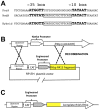Mutant Native Outer Membrane Vesicles Combined with a Serogroup A Polysaccharide Conjugate Vaccine for Prevention of Meningococcal Epidemics in Africa
- PMID: 23805230
- PMCID: PMC3689835
- DOI: 10.1371/journal.pone.0066536
Mutant Native Outer Membrane Vesicles Combined with a Serogroup A Polysaccharide Conjugate Vaccine for Prevention of Meningococcal Epidemics in Africa
Abstract
Background: The meningococcal serogroup A (MenA) polysaccharide conjugate vaccine used in Sub-Saharan Africa does not prevent disease caused by MenW or MenX strains, which also cause epidemics in the region. We investigated the vaccine-potential of native outer membrane vesicles with over-expressed factor H-binding protein (NOMV-fHbp), which targeted antigens in African meningococcal strains, and was combined with a MenA polysaccharide conjugate vaccine.
Methodology/principal findings: The NOMV-fHbp vaccine was prepared from a mutant African MenW strain with PorA P1.5,2, attenuated endotoxin (ΔLpxL1), deleted capsular genes, and over-expressed fHbp in variant group 1. The NOMV-fHbp was adsorbed with Al(OH)3 and used to reconstitute a lyophilized MenA conjugate vaccine, which normally is reconstituted with liquid MenC, Y and W conjugates in a meningococcal quadrivalent conjugate vaccine (MCV4-CRM, Novartis). Mice immunized with the NOMV-fHbp vaccine alone developed serum bactericidal (human complement) activity against 13 of 15 African MenA strains tested; 10 of 10 African MenX strains, 7 of 7 African MenW strains, and 6 of 6 genetically diverse MenB strains with fHbp variant group 1 (including 1 strain from The Gambia). The combination NOMV-fHbp/MenA conjugate vaccine elicited high serum bactericidal titers against the two MenA strains tested that were resistant to bactericidal antibodies elicited by the NOMV-fHbp alone; the combination elicited higher titers against the MenA and MenW strains than those elicited by a control MCV4-CRM vaccine (P<0.05); and high titers against MenX and MenB strains. For most strains, the titers elicited by a control NOMV-fHbp knock out vaccine were <1∶10 except when the strain PorA matched the vaccine (titers >1∶000).
Conclusion/significance: The NOMV-fHbp/MenA conjugate vaccine provided similar or higher coverage against MenA and MenW strains than a quadrivalent meningococcal conjugate vaccine, and extended protection against MenX strains responsible for epidemics in Africa, and MenB strains with fHbp in variant group 1.
Conflict of interest statement
Figures







Similar articles
-
A meningococcal NOMV-FHbp vaccine for Africa elicits broader serum bactericidal antibody responses against serogroup B and non-B strains than a licensed serogroup B vaccine.Vaccine. 2016 Jan 27;34(5):643-649. doi: 10.1016/j.vaccine.2015.12.034. Epub 2015 Dec 20. Vaccine. 2016. PMID: 26709637 Free PMC article.
-
A Meningococcal Outer Membrane Vesicle Vaccine with Overexpressed Mutant FHbp Elicits Higher Protective Antibody Responses in Infant Rhesus Macaques than a Licensed Serogroup B Vaccine.mBio. 2019 Jun 18;10(3):e01231-19. doi: 10.1128/mBio.01231-19. mBio. 2019. PMID: 31213564 Free PMC article.
-
Meningococcal factor H binding proteins in epidemic strains from Africa: implications for vaccine development.PLoS Negl Trop Dis. 2011 Sep;5(9):e1302. doi: 10.1371/journal.pntd.0001302. Epub 2011 Sep 6. PLoS Negl Trop Dis. 2011. PMID: 21909444 Free PMC article.
-
Meningococcal serogroup B vaccines: Estimating breadth of coverage.Hum Vaccin Immunother. 2017 Feb;13(2):255-265. doi: 10.1080/21645515.2017.1264750. Epub 2016 Dec 14. Hum Vaccin Immunother. 2017. PMID: 27960595 Free PMC article. Review.
-
Characteristics of a new meningococcal serogroup B vaccine, bivalent rLP2086 (MenB-FHbp; Trumenba®).Postgrad Med. 2016 Aug;128(6):548-56. doi: 10.1080/00325481.2016.1203238. Epub 2016 Jul 7. Postgrad Med. 2016. PMID: 27467048 Review.
Cited by
-
A meningococcal NOMV-FHbp vaccine for Africa elicits broader serum bactericidal antibody responses against serogroup B and non-B strains than a licensed serogroup B vaccine.Vaccine. 2016 Jan 27;34(5):643-649. doi: 10.1016/j.vaccine.2015.12.034. Epub 2015 Dec 20. Vaccine. 2016. PMID: 26709637 Free PMC article.
-
A Meningococcal Outer Membrane Vesicle Vaccine with Overexpressed Mutant FHbp Elicits Higher Protective Antibody Responses in Infant Rhesus Macaques than a Licensed Serogroup B Vaccine.mBio. 2019 Jun 18;10(3):e01231-19. doi: 10.1128/mBio.01231-19. mBio. 2019. PMID: 31213564 Free PMC article.
-
Investigating the Role of Antigen Orientation on the Immune Response Elicited by Neisseria meningitidis Factor H Binding Protein on GMMA.Vaccines (Basel). 2022 Jul 26;10(8):1182. doi: 10.3390/vaccines10081182. Vaccines (Basel). 2022. PMID: 35893831 Free PMC article.
-
The development of an experimental multiple serogroups vaccine for Neisseria meningitidis.PLoS One. 2013 Nov 14;8(11):e79304. doi: 10.1371/journal.pone.0079304. eCollection 2013. PLoS One. 2013. PMID: 24244473 Free PMC article.
-
Contribution of factor H-Binding protein sequence to the cross-reactivity of meningococcal native outer membrane vesicle vaccines with over-expressed fHbp variant group 1.PLoS One. 2017 Jul 25;12(7):e0181508. doi: 10.1371/journal.pone.0181508. eCollection 2017. PLoS One. 2017. PMID: 28742866 Free PMC article.
References
-
- Greenwood B (1999) Manson Lecture. Meningococcal meningitis in Africa. Trans R Soc Trop Med Hyg 93: 341–353. - PubMed
-
- Cohn AC, MacNeil JR, Harrison LH, Hatcher C, Theodore J, et al. (2010) Changes in Neisseria meningitidis disease epidemiology in the United States, 1998–2007: implications for prevention of meningococcal disease. Clin Infect Dis 50: 184–191. - PubMed
-
- Harrison LH, Trotter CL, Ramsay ME (2009) Global epidemiology of meningococcal disease. Vaccine 27 Suppl 2B51–63. - PubMed
-
- Jodar L, LaForce FM, Ceccarini C, Aguado T, Granoff DM (2003) Meningococcal conjugate vaccine for Africa: a model for development of new vaccines for the poorest countries. Lancet 361: 1902–1904. - PubMed
Publication types
MeSH terms
Substances
Grants and funding
LinkOut - more resources
Full Text Sources
Other Literature Sources
Research Materials

